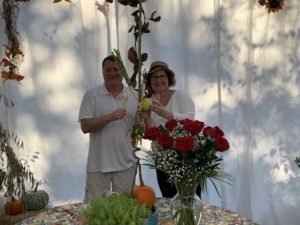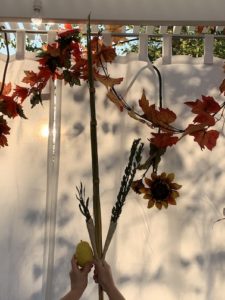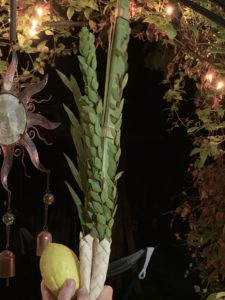Our Anniversary In The Sukkah
Twenty seven years ago, my husband and I stood under the huppa (chuppa) and made our vows to stick together through the best and worst of times and everything in between. We made a commitment to create a life together based on Jewish values under the watchful eye of God, that’s what a huppa is all about.
Today, on the last day of Sukkot, which is also Shabbat, known as Hoshana Rabbah, we are renewing our vows to each other and, by doing certain rituals under the sukkah, we are renewing our vows to God and the the Jewish people.
When I was a bride I clutched a bouquet of ivory roses as I walked down the aisle towards my soon-to-be husband who stood under the huppa waiting for me with a nervous smile on his face. Today, I hold in my hand the sweet smelling fruit called etrog (esrog) with the palm, myrtle and willow branches of the lulav, and wave the Four Species together in all directions in the sukkah. Scott’s still smiling, but this time because I’m shaking my lulav and we’re having strudel for dessert.
Lulav and Etrog Symbolize Unity
I have chosen Sukkot as the theme of this year’s anniversary–why not–considering the actual modern gift associated with the 27th year is “sculptures.” So, here’s my attempt to connect the meaning of the sanctity of marriage to this joyous holiday.
The lulav and etrog can be compared to a married couple, who bring their own unique qualities and strengths to a relationship. A lulav is a slender palm branch that is held together with two willow branches and three willow branches. An etrog, or citron, looks like an enlarged bumpy lemon and a whiff of the subtle scent is heavenly and intoxicating. Together, the branches and fruit have their own beauty and symbolism.
A midrash explains that the Four Species symbolize the importance of unity among different types of Jews. The etrog has both a flavor and a scent, like a Jew who is both learned and observant of the commandments. The lulav is from a date palm, and so it has a taste but no scent. It is likened to a Jew who is learned but does not apply that knowledge in action. A myrtle has a pleasant odor but no taste, and it represents the Jew who has little book learning behind his or her observance. Finally, the willow lacks both fragrance and taste, just like the Jew who neither studies the Torah nor keeps the commandments. These differences among Jews are substantial, yet we can still come together in solidarity, just as the lulav and etrog are bound together to merit a blessing. Same as a married couple. We bring our own unique qualities to the relationship, and we are better, stronger when we are committed as one.
Falling In Love
To celebrate our anniversary amidst a pandemic, this is what I had in mind. We will get flu shots, vote, and have a candlelit dinner in the sukkah. Romantic, huh? The next day, Saturday, is Simchat Torah, a Jewish holiday that marks the conclusion of the annual cycle of public Torah readings. If there wasn’t a contagious deadly virus still lurking, crowds of people traditionally would go to synagogue and sing and dance around the Torah–talk about an ultimate wedding reception. Even though we won’t be partaking in these activities, Simchat Torah is meaningful to us because the holiday represents a new beginning, just like our anniversary. This holiday is a time to fall in love all over again, with each other, our faith, and our faith in each other.
Sukkah Brings It All Home
Actually, being together on our anniversary is a gift, so is a vase full of red roses and a box of chocolates. But in this frightening, unpredictable corona world that we are trying to survive and live in, we are reminded that everyday is a gift, really, and Sukkot reminds us that we have everything we need to get through it all. The makeshift structure that we build in the backyard is a symbol of our humbleness and appreciation for the simple things in life, like a roof over our head. When people come together to dwell inside a sukkah, we are equal. We are all God’s children. In this outdoor hut, and at this moment, we have all we need. The material wealth that lurks outside the sukkah doesn’t matter and actually exists to divide us. So we relish this moment to be together outside in nature, with the sun and the stars peeking through the slats in the roof. Focusing on what really matters, the simpler things, gives us a better chance of long lasting love, happiness, and fulfillment just as in marriage.
Huppa Provides Protection From Above
In Jewish tradition, a couple gets married under a huppa, a bridal canopy that can decorated with linens, flowers, however simple or elaborate beauty is to the beholder. The roof of a sukkah, the s’chach, is meant to be beautiful in an earthy, rustic way with natural materials, such as tree branches, palm leaves, bamboo rods, any organic material that has grown from the ground. Both the huppa and the s’chach are symbolic, as they invite God to witness our holy act, whether we wave the lulav and etrog or make the commitment to spend the rest of our lives together. Being a Jew and following the commandments is not easy and requires time to flourish and grow, as well as dedication, and the ability to think outside of ourself, sounds a lot like marriage.
The marriage canopy represents a home that the bride and groom create, just as the biblical patriarch Abraham and his wife Sarah opened their tent to visitors and welcomed  guests as a gesture of hospitality. On Sukkot, it’s a mitzvah to welcome guests, known as ushpizin, into our sukkah to enjoy the holiday with us. Because of corona, the guest list of family and friends will be shorter this year, however, we always make room for the spiritual guests, or the Seven Shepards. These are Abraham, Isaac, Jacob, Moses, Aaron, Joseph and David. The sukkah, like a huppa, signifies the presence of God, and I can’t think of better guests to have at our simcha than God and our patriarchs guiding us.
Being A Jew Means Saying “I Do”
We chose to be married in the fall because the change in seasons is our favorite time of year. The weather is sunny and crisp, the leaves are full and colorful, and change is in the air. And this year our anniversary falls on Sukkot, a new beginning for us, a new year for the Jewish people. This 27th anniversary is a reminder that we have God’s blessing every step of the way. As all married couples will attest, falling in love is the easy part; the marriage, the commitment, is the hard part.
The sukkah is a tabernacle that was built to shelter the Jewish people and protect them on their long, difficult travels in the desert, much like a marriage is the foundation that supports us on our life’s journey of twists and turns.
Like the huppa, the sukkah is a temporary structure, built by our own two hands, and so is the marriage that we create. Under the huppa and the sukkah, we vow to God to build a home, a family, and a future. As the white flowing curtains that frame the sukkah blow in the wind and the crunchy yellow and red leaves fall all around us, I’m reminded that marriage and life is fleeting, always moving, and as fragile as the glass we shatter under our foot and cheer, “Mazel Tov!” So we will enjoy the moment while we have it.
Shabbat Shalom, Chag Sameach, and Happy Anniversary to us.




